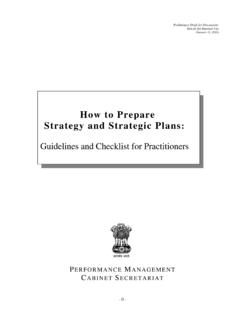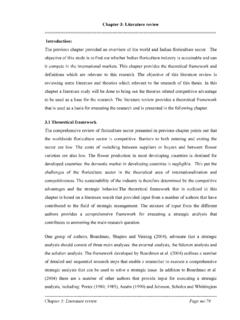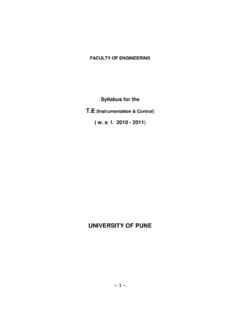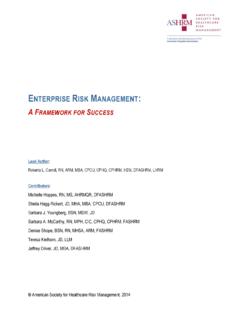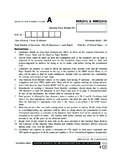Transcription of NGO MANAGER ORGANISATIONAL ASSESSMENT …
1 NGO MANAGERORGANISATIONAL ASSESSMENT tool (OAT)_____Latest version available at: 2004 ORGANISATIONAL ASSESSMENT tool (OAT)2/24 JULY 2004 NGO MANAGERORGANISATIONAL ASSESSMENT tool (OAT)Marco Kirschbaum* and characteristics of the to plan and carry out an ORGANISATIONAL ASSESSMENT ?.. a swot analysis : Strengths, Weaknesses, Opportunities and swot swot Action #1: ORGANISATIONAL ASSESSMENT - Question #2: swot analysis Brainstorming Sheet ..21 Worksheet #3: swot analysis Action Plan Sheet ..22 Worksheet #4: ORGANISATIONAL ASSESSMENT Summary * Very special thanks to Pauline Sawh and Daniel D Esposito for their time, knowledge, experience, patience andsupport.
2 ORGANISATIONAL ASSESSMENT tool (OAT)3/24 JULY and characteristics of the tool The purpose of the ORGANISATIONAL ASSESSMENT tool (OAT) is to helporganisations to improve their performance. It helps to find out their strong andweak points. The OAT is a learning tool on problems and questions concerningthe organisation s strategy, it s management processes, finances, staffing,relationships with others and it s results. It asks to identify causes of problemsand helps in the decision-making to overcome tools are also important for consultants and support organisations,which help NGOs to build their capacity. Ideally, an ORGANISATIONAL assessmentis carried out periodically to measure change and improvement.
3 The tool is simple, task-focused and action-oriented. The statements of thequestionnaire describe the expected capacity of a mature or developedorganisation. The characteristics of the OAT are as follows: Contains a comprehensive list of relevant management issues Promotes process-orientation instead of static listing of positive and negativepoints. The OAT focuses on identifying strengths, weaknesses, opportunitiesand threats with regard to each issue ( swot analysis ) Helps to focus on causes of problems instead of highlighting symptoms only Favours a participatory approach for the ASSESSMENT , dialogue andtransparency on its results. It can be used both by an individual and bygroups.
4 Leads to qualitative statements instead of giving grades Includes a detailed results section, which asks what the organisationsachievements are Provides users with quick overview of level of achievement for eachmanagement issue Results in a clear list of priority subjects for improvement for each issueanalysed Facilitates the setting up of a plan of action Contains easy-to-use worksheets, which can also be used to report on theresults of the ASSESSMENT tool (OAT)4/24 JULY 2004 Many of the existing ASSESSMENT tools are difficult to adapt and modify becausethey are in PDF or HTML format that cannot be modified if downloaded. TheOAT worksheers can be downloaded as Microsoft Word file and thus beadapted to your particular needs (see ).
5 This is important because each organisation faces different managementchallenges and needs to adapt the tool to its particular situation: a newlyestablished organization will need to build up the foundations of the NGO andhave to pay more attention to its governance structure, the board, the leadershipsystem and accounting. An established and somewhat developed organisationmay need to put particular emphasis and work on its human resources andplanning systems. Mature organisations may focus on ASSESSMENT , change andmanagement processes. Therefore each ASSESSMENT MANAGER will need to beable to adapt the ASSESSMENT tool to the organisation's particular needs at thatmoment, selecting certain issues, deleting others and thus creating its own OAT is conceived as an open source instrument.
6 Your are free to use it andto adapt it to your needs. We would very much appreciate if you could send usyour comments and suggestions to improve the tool either directly on thetemplate or in a separate email. Contributions will be acknowledged andmentioned at the NGO MANAGER s website (in case you do not object). to plan and carry out an ORGANISATIONAL ASSESSMENT ? There are three steps for such an ASSESSMENT :Step 1: Prepare the ASSESSMENT Define the scope of the ASSESSMENT : choose between carrying out acomprehensive ASSESSMENT , ie. answering all of the questions in theQuestion Menu, or a selective ASSESSMENT , ie. selecting the topics whichare the most important to your organisation at this time.
7 Adapt the Question Menu to suit your specific needs. This tool is easy toedit because all the worksheets are in a commonly used anddownloadable format (Microsoft Word). Decide on who among managers and staff will participate in theassessment. Decide whether an internal ASSESSMENT MANAGER or anexternal facilitator is best suited to lead the ASSESSMENT process. Decide on the form and timing of the enquiry: structured or semi-structured interviews, team-based discussions, ASSESSMENT tool (OAT)5/24 JULY 2004 Step 2: Carry out the ASSESSMENT Answer the questions in the Question Menu according to themethodology you have chosen in step one.
8 For each question, determine your level of achievement, the keyrecommendations and their level of priority and record the answers onthe Question now may have a good overall picture of the current capacity of yourorganisation. You also have established recommendations for next step is to set up a plan of action to implement these plan of action should take into account internal as well as external internal strengths and weaknesses, and external opportunities andthreats, or swot analysis , is the ASSESSMENT s key tool to create the plan ofaction:Step 3: Create a plan of action Do a swot a for each of the questions using the swot BrainstormingSheet.
9 Brainstorming is most productive in a group. Identify relevant actions to be taken based on the results of the swot analysis using the swot Action Plan Sheet. Use the Summary Sheet to present your plan of a swot analysis : Strengths, Weaknesses, Opportunities and Threat s swot analysis is an effective, simple and widely used tool . It can be carried outindividually and in groups. The organisation s internal situation is describedunder the headings of strengths and weaknesses. The external factors arecondensed under the headings of opportunities and threats. To complete acomprehensive overview, the main causes for each factor should be identified,whenever it is useful and swot analysis is needed for each sub-topic of the questionnaire.
10 Theanalysis and discussions can be carried out in two steps: swot BrainstormingThe purpose of the swot brainstorming is to identify and list the key issues atstake and underlying causes. Group sessions are very often most effective forthat purpose. In preparation of swot group sessions, it is useful to askORGANISATIONAL ASSESSMENT tool (OAT)6/24 JULY 2004participants to prepare in advance his or her own swot analysis . The results ofindividual analysis can then be merged during the group session. swot analysis usually stimulates a multitude of different views. These shouldbe recorded in the group s swot brainstorming notes and can be weighed, ifneeded.


